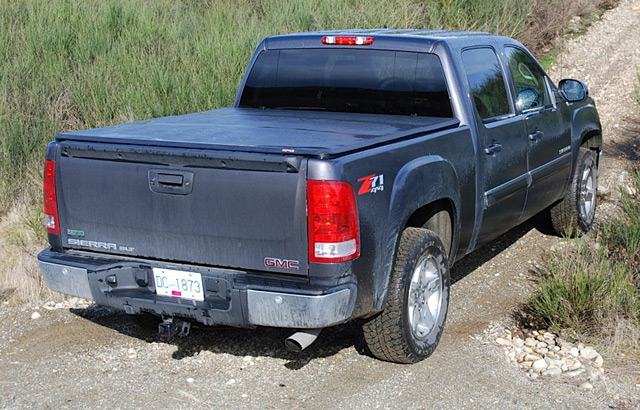Plenty of folks buy a 4X4 pickup truck or SUV and never intend to take it off-road. In fact, plenty of those same folks never even think about actually using the vehicle's capabilities to their fullest. They simply want the peace of mind that comes with the fact they can switch from two-wheel drive (2WD) to four-wheel drive (4WD) with either the tug of a lever or (even more common today) the turn of a switch. If you're in that same group, have you ever wondered what the controls for the 4WD system actually do? And, equally important, when and where you should use them? If so, you're not alone. Here's a 4WD how-to to help you get to know your four-wheel-drive vehicle:
There are several different types of 4WD systems. The two most common include full-time 4WD and part-time 4WD.
Full-Time 4WD means the vehicle is always making power available to all four wheels, typically shifting the power from the front and rear axles as necessary. Full-time 4WD offers maximum traction under all conditions, and does not require additional input from the driver (to turn on or off). Due to the nature of a full-time 4WD system, you'll find the vehicle does not have the overall on-road mobility of a part time 4X4 package.
Part-Time 4WD means the vehicle has a means to select between 4WD and 2WD. It could be a lever or it could a switch. With this setup, you shift between 4WD and 2WD on the go. A vehicle with part-time 4WD provides superior traction on slippery surfaces because the front and rear sets of wheels are (obviously) locked together.
It's important to note that vehicles with part-time 4WD systems should not be driven on dry, smooth road surfaces when in 4WD mode. The constant use of 4WD under these conditions can damage drivetrain components.
There are also certain automatic 4WD systems offered that allow the vehicle to operate in 2WD until the system senses a need for 4WD, or all-wheel drive (AWD). The system automatically routes the power delivery to all four wheels, varying the amount of power provided to the respective axles as necessary.
Most often, a sensor is triggered by a slipping wheel, which, in turn, engages the 4WD. Keep in mind that some of these systems are not designed for serious off-roading (usually in vehicles where the front axle does the principle amount of work). On the other hand, applications—such as those found under some pickup trucks where the rear axle does the principle amount of work in 2WD—are more than off-road capable.
Your owner's manual will explain what type of 4WD system your vehicle is equipped with. Most manufacturers offer detailed information on where and when to use 4WD. Nonetheless, here is a synopsis of where and when to engage the system:
High-Range 4WD
4-High allows you to drive full speed, if necessary (keeping in mind the caveat mentioned earlier regarding driving on dry pavement). The high-range ratios in 4WD mode are the same gear ratios as the vehicle has in 2WD mode.
When to use 4-High:
- Additional traction when the terrain isn't steep
- Snow
- Ice
- Muddy roads or when operating where there is no road
- Rocky, gravel roads
- When stuck in sand or snow
- Under extremely slippery condition
Low-Range 4WD
4-Low alters the gearing in your vehicle. It is designed so you can creep along at slow speeds (which also reduces the potential for damage to your vehicle). Most manufacturers recommend you do not exceed 45 mph in 4-Low. Keep in mind that 4-Low does not provide more traction. Instead, it provides considerably more torque (often 2-3 times that of 4-High at very low speeds.
When to use 4-Low:
- On wet, slippery surfaces
- In heavy, wet snow
- Climbing or descending steep hills
- On very rough terrain (trails, off road)
- Powering through mud
- Climbing rocks
- Driving through deep sand
- Fording water
Four Wheeling Tips
1. Most systems can be shifted into 4-Low as the vehicle is moving forward very slowly at 1-2 MPH with the transmission in neutral. Alternatively, you can stop the vehicle completely and engage 4-Low. Wait for the drive system lamp to stop flashing before shifting the transmission into gear.
2. To shift back from 4-Low to 4-High, slow to 1-2 mph with the transmission in Neutral. Wait for the drive system lamp to stop flashing before shifting the transmission into gear.
3. Always engage 4-Low before you need it, and if you're in doubt about the conditions, slow down and select 4-Low.
4. Never operate 4WD on hard dry surfaces.
5. If the vehicle has an "Auto" setting, it will prove ideal for use when road surfaces vary (for example, wet or dry, snowy or dry, etc.). Typically, driving in this mode results in slightly lower fuel economy than the 2WD mode.
6. Even with 4WD, slow and steady is much more important than fast and aggressive.
7. When in 4WD, the front wheels will feel as if they are "pushing" or "skidding" in a tight turn. Don't worry! This is normal.
8. Treat loose or wet surfaces as if they are ice. That means you should do everything (brake, accelerate, turn) slowly and gently. This approach keeps the tires from spinning on acceleration and it also keeps them from locking up on deceleration.
9. If you have driven through deep water or mud or deep wet snow, apply your brakes several times at low speed to dry them out. Keep in mind that water, mud and deep snow will affect brake operation.
You'll soon discover that your four-wheel drive likely has capabilities you never dreamed possible. Remember to check your vehicle owner's manual for more information along with vehicle-specific dos and don'ts. You can also check out the accompanying photos for further info.











